Kayla Sloan is an entrepreneur with a small niche: teaching others how to become successful virtual assistants.
She has a course: $10K VA®, which, as the name suggests, is a roadmap to earning $10,000 per month helping other entrepreneurs.
She’s really well known in her corner of the internet, and one thing that strikes me about her is that everyone who knows her has something wonderful to say about her.

That’s unique anywhere, and especially so in the online world.
She’s built a reputation as:
- Someone who can be trusted with tight deadlines and quality output
- Someone who can teach others how to replicate her success
- Someone who builds effective systems for entrepreneurs
- And someone who is a pleasure to work with
We worked together in 2019 to grow sales of her course and other digital products.


And so, with her permission, I wanted to give a peek behind the curtain as to five strategies we used to quadruple her online revenue from 2018 to 2019.
It’s my hope with this article to show you what’s really possible with online marketing for digital products, specifically courses.
Specifically, this course.
About Kayla Sloan and $10K VA®
Kayla Sloan made a name for herself as the go-to virtual assistant in the online personal finance community. She started blogging in 2013 and everyone knew her in under a year as the systems person who made running a blog work.
I met her sometime in 2015, at the annual gathering of personal finance bloggers and podcasters, FinCon. A couple of years later, she approached me, telling me that many people kept approaching her and asking how to become a virtual assistant.
“How many people would you say ask you this?” I asked, ears perking up.
“Oh, probably ten or 15 a month,” she replied.
Actual footage of my response
“Uh, you should probably make a course,” I told her. “In fact, you need to publish that course by the end of the year!”
We parted ways. The conversation didn’t leave much of an impression on me, but it left a big impression on her, because a few months later, she emailed me.
“I did it! I created the course! Can you write me a sales page for it?”
So I did. Again, I didn’t think much of it.
The next time I saw her in person, she said she’d made $25,000 on the course.
“Not bad!” I told her. I was impressed.
“And,” she added, “I don’t even have a link to it from my home page!”
“Wait. You made that money without marketing it?”
\These conversations, especially that last one, led me to offering something I only offer to very few people: a revenue share.
The contract she signed was this: I’ll do all her marketing, except the things that absolutely need her voice (her live webinars, for example, were things she had to host herself), and take a percentage of all online sales for 2019.
We signed the contract, and got to work.
Summary of our strategy
We grew $10K VA® to six-figures a year of topline revenue, replicable after our arrangement ended, using the following strategies:
- Market the heck out of her existing course using everything in our arsenal
- Build a higher-end product that targets a different, related audience
- Utilize Kayla’s existing relationships to build a more robust affiliate strategy for both products
- Experimenting with different pricing models for her existing course
- Swapping out the text you think no one is looking at…but they are!
And that was it. We didn’t have a content strategy, necessarily, because she’d built up a great audience already. She had a closed Facebook group, a good relationship with the new target audience we were going after with the higher-end product, and put her blog posting on autopilot (or at least that’s how it appeared from where I sat at the marketing desk).
Tip 1: Market the heck out of her existing course using everything in our arsenal
The first thing I wanted to do was create a marketing engine around her course. Her course was already selling decently. She’d recently increased her price.
That was a few months before we started working together, which meant she wasn’t ready to increase the price. She agreed with me that the only reason to increase prices is if she added something, and she hadn’t in the last few months. So she just wasn’t going to increase the price again.
But, even without the price adjustment, we were working with a blank slate when it came to marketing.
Kayla is good on camera. She comes across very confident, relatable, and someone with a lot of authority. So hers is the kind of voice and face we want to have doing more videos, more workshops, more webinars.
We want her walking people through her systems and displaying her expertise.
So I built a webinar marketing strategy that she used every month for the year that we work together. The first month, it took a bit of organizing, but by the time we’d done it five or six times, it was seamless.
We ran that webinar live until Kayla was sick and tired of every slide. Many entrepreneurs miss this piece: when you do something multiple times, it’s easier to do than if you only do it once.
Kayla understood this. So instead of:
- Brainstorming a new topic
- Building a new slide deck
- Learning a new script
every month, all she had to do was get better at the slide deck she already knew.
The only difference was the audience. Who would come?
Same webinar, multiple date/time combinations
Based on that logic above, doing the same webinar three times is not nearly as complicated as you’d think. Logically, you’d think you’d have to put in three times as much effort to run it three times, but that’s simply not true.
In fact, you’ll be better prepared the second time you run it live, too.
So each month, we set a variety of times and days to catch as many people as possible on their timelines and schedules.
I set up a registration page that looked like this:
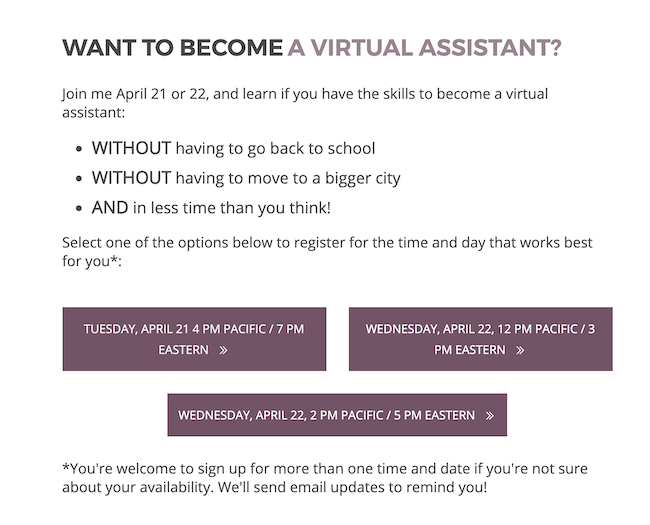
Send paid traffic to a registration page with multiple date/time combinations
Since we were doing three different days/times, we knew we could send paid traffic to one registration page and have someone actually click through because we were accommodating their timelines.
Webinar: my 30/40/30 framework
The webinar was set up in my 30/40/30 framework, which you can learn more about here.
Tip 1 SUMMARY: Understand that a webinar has a lot of moving pieces, and simplify where you can
Treat every time you put these together as a learning experience. Get better with each iteration. Offer multiple days/times to accommodate schedules and get a better return on your paid ad spend. Keep doing what’s working, and don’t change until something stops.
Tip 2: Build a higher-end product that targets a different, related audience
Kayla’s primary audience is virtual assistants and people who want to become virtual assistants.
But her secondary audience is business owners who were looking for a virtual assistant themselves, but they didn’t know how to get started.
And so, for many people in this world, the only experience they had with business development, and management was as a managed person in a corporate environment, not as a manager.
What that meant was that they didn’t know how to manage, let along how to manage and work with assistants virtually. And usually when they tried to hire something out, they didn’t do a good job setting expectations as a manager, leaving them feeling like hiring a VA just wasn’t going to work for their business.
And so they would dismiss the idea of building a team right away.
They’d say things like:
- “This didn’t work for me”
- “Hiring a virtual assistant can’t be done in my business”
- “I don’t know how I’m ever going to get everything done because I can’t outsource anything”
That was such an opportunity for Kayla to create the very thing these business owners needed: Six Figure Systems.
Create a new offer together: Six Figure Systems
Six Figure Systems is a high-end service for business owners, not a course, and it’s one that Kayla pours herself into, which means it’s a much higher price than her VA course.
Six Figure Systems is essentially a crash course on outsourcing and working with a team. Kayla helps business owners identify what types of things they specifically need to hire for in their business, plus she helps them find, hire, and train their first virtual assistant (VA).
Instead of having frustration and miscommunication cause the VA or business owner to throw in the towel, Kayla becomes a liaison of sorts to ease communication difficulties between the business owner and the VA, but she’s also there to help with re-hiring or replacing the VA in the event things don’t work our, or to help with hiring additional VA(s) and other virtual team members, if necessary.
Target: People who need virtual assistants (rather than people who want to become virtual assistants)
It’s targeting people who want someone like Kayla to come in and help them. And what it actually did was provide an opportunity for her best VA course students to get really good jobs right away.
We built that early on, we started promoting it, and then we pivoted back toward marketing her course, because we weren’t getting traction as quickly as she wanted with this new offer.
The traction for this came in the second half of the year, but it wouldn’t have if we didn’t have that offer established and mapped out in the first half of the year. A reminder to anybody who’s thinking about building another product or service: there is a time to be planting and a time to be harvesting. And those are never at the same time. So give your ideas six months and then see what, if, any fruit bears.
Tip 2 SUMMARY: Brainstorm and outline a high-ticket offer.
Advertise it. If it doesn’t convert right away, set it aside. It may come back to be a bigger part of your revenue later in the year.
Tip 3: Utilize existing relationships to build a more robust affiliate strategy
When I work with clients on one-off webinar projects (Webinar IMPACT), I tell them to ignore paid ads and affiliate strategies.
Why?
Because when you’re creating your first webinar, you already have a lot you need to keep track of. A lot of pages to build, emails to write, shopping carts to configure.
And adding “figuring out paid ads” or “come up with an affiliate strategy” to your already-full plate makes it all seem like just too much.
But that’s one of the beautiful things about a revenue share: Kayla wasn’t a one-off client.
As I’ve said before, Kayla has a rock solid reputation in her corner of the internet. Everybody knows who she is. Everybody wants to help her succeed. Affiliate strategies don’t work for everyone, because not everyone is as connected as Kayla.
But part of her power is her community. She has a lot of friends and colleagues who are sending messages to the same people she’s trying to reach. People in her community lift each other up and that’s such a cool thing.
There’s power here, too. You still have to spend money, but in an affiliate model, you give money to your friends (and you only have to part ways with your money once someone converts) instead of giving money for each page view on Facebook.
Tip 3 SUMMARY: Develop an affiliate program and give your friends a percentage of every course sale.
You’re going to have to spend money anyway, so reach out to your friends and see if they’re willing to help promote your course. Support their efforts. It’ll go a long way.
Tip 4: Experiment with different pricing models
Toward the end of the year, we started experimenting with a different pricing model for $10K VA®.
There were two data points that made me think about adding a new pricing model for Kayla’s course:
- Before we started working together, the vast majority of signups to her course came in the run up to her price increase;
- Another business I know and support, Wandering Aimfully, had a lifetime model, played with a monthly membership fee, then switched back to a lifetime model. Their data was fascinating:
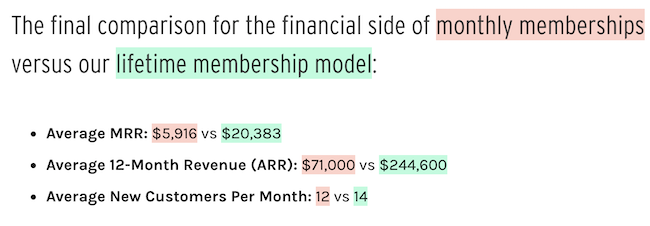
The idea was simple: add a similiar lifetime model to her pricing table.
So instead of getting a bunch of money up front she was going to get approximately $200 a month for nine months for each person who decided to be in lifetime.
And according to the article Jason wrote, switching to a lifetime model resulted in a lot fewer chargebacks.
A lot more happy people. And happy people don’t ask for refunds.
This is what Kayla’s pricing structure looks like now:
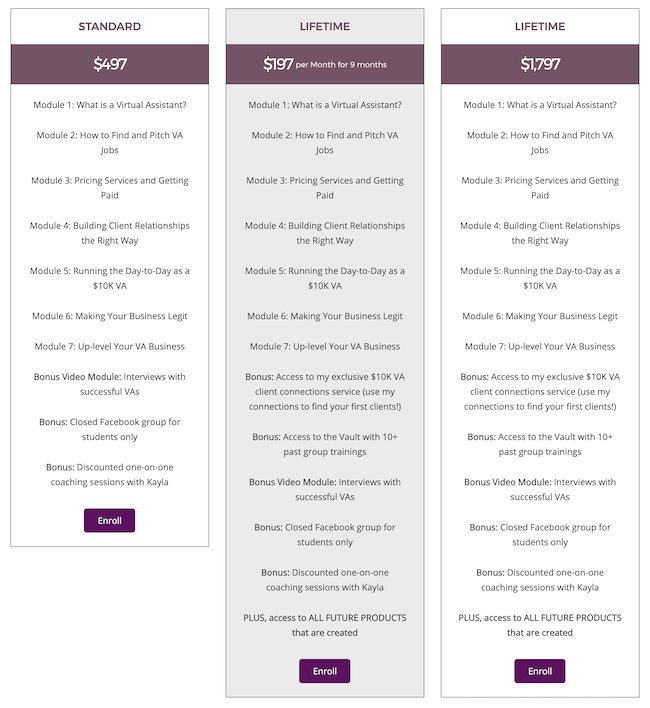
Her standard course is a good deal: learn everything you need to know about how to become a sought-after virtual assistant.
But her lifetime model is a really good deal: access to her exclusive client connection service (so VAs can match up with those business owners we talked about earlier), access to all past group trainings, and, best of all: free access to anything related that she creates in the future.
Two reasons to consider a lifetime model in your business
Positioned next to the standalone course, Kayla’s lifetime option looks like a great deal (which is why I brought up the data point about everyone buying before the price goes up).
People like to feel like they’re getting a good deal. And people buy from people.
So being both friendly and authoritative is basically step zero.
But the puzzle we had to figure out was how to keep people showing up for Kayla. There’s a lot of learning that comes after someone gets their first gig as a VA, and that kind of work, especially early on, can become overwhelming.
And for Kayla, it means, no matter how many one-off sales of a workshop she’s offering, she’s not teaching to an empty room. Her lifetime students can join in on those training sessions, and they do. She gets to form a deeper connection to her audience, which can lead to more opportunities to get together online or offline down the road.
Her revenue increased, but not dramatically, and only in the aggregate. So initially, this experiment looked like a failure, which happens when you only look at numbers on a spreadsheet instead of what those numbers actually represent.
She saw more $197 payments and not as many $1797 payments, which made her feel like she was earning less.
But her chargebacks immediately decreased.
One reason not to switch your pricing model
I asked Kayla for some input before the post went live, and she wanted to give a big huge caveat.
Here’s what she had to say:
“The lifetime value of the customer on the payment plan is less than it was before we implemented the lifetime model — by roughly half — but the students are getting everything extra that’s available in the new lifetime model. Even though we have fewer chargebacks, what we have instead are a lot of failed payments.
There is also a lot of admin work required to follow up with failed payments, which costs me money.
The article you mention isn’t a 1:1 of my business model. They had a monthly recurring subscription already before adding the lifetime model with a fixed payment plan, and I didn’t. I think that’s why their numbers are the way they are and that’s why their lifetime model worked so well for them.
But for me, it was different. I went from a full, one-time payment with little to no admin work or follow up required after the sale, to now giving them more content and doing more admin work to chase down their money because the payments fail.
Plus, the new students who have purchased since we added the lifetime option with a fixed payment plan seem to see it as a subscription that can be canceled — not a payment plan that must be paid in full — even though the language is clear on every piece of material we put out.
I think this also speaks to the quality of students potentially being lower after implementing the lifetime option with a low monthly payment plan because the customer who pays $200 per month for something is different from the customer who pays in-full.
I’m not 100% convinced that I’ll stick with my current payment plan for students in the lifetime model, but I do see how switching to a lifetime model with a fixed payment plan could be useful for people who currently have a monthly subscription product.”
Tip 4 summary: test out different pricing models.
But don’t get tied to one over another. See what works and measure the right things.
Tip 5: Swap out the text you think no one is looking at
The first webinar I put together for Kayla was an on-demand webinar. This is something I often do for clients first, before pushing them to do a live webinar.
It’s better to think of an on-demand webinar as a lead-generating opt-in and a live webinar as your sales vehicle.
So we put one together.
And I swapped out the language on her home page from some sort of generic “sign up for our newsletter” and replaced it with language around coming to the on-demand webinar.
Top of home page:
Here’s what was there before we started working together:
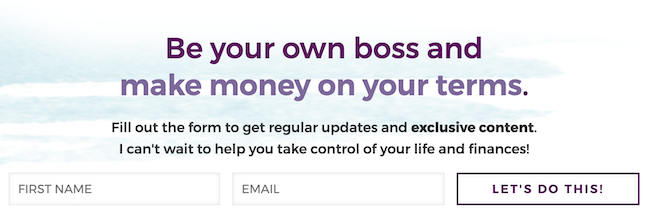
Generic “join the newsletter” option at the top. Not offensive, but not altogether useful.
I swapped out the language and replaced it with:

Bottom of home page:
Here’s what was there before:

Again, not bad.
But this is what I replaced that with:
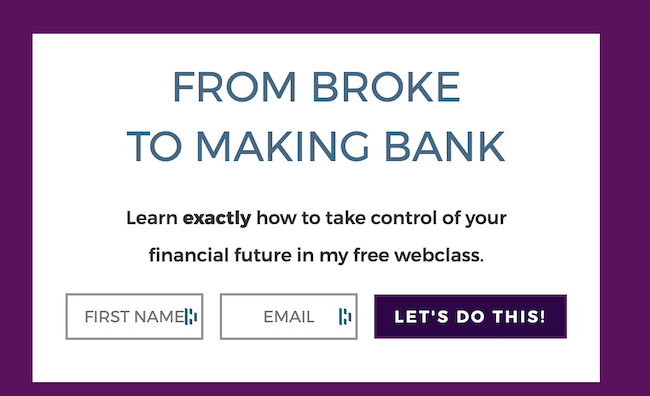
And the results were amazing.
That one change made such a big difference in terms of email subscribers.
Here’s when we made the change:
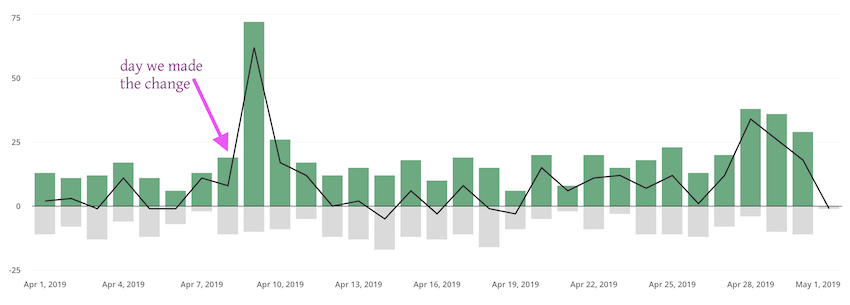
And even though her home page looks different today, and is advertising a new webinar, the change we made over a year ago made her email subscribers jump to 50-75 per day, a number that is sustained even as of this writing: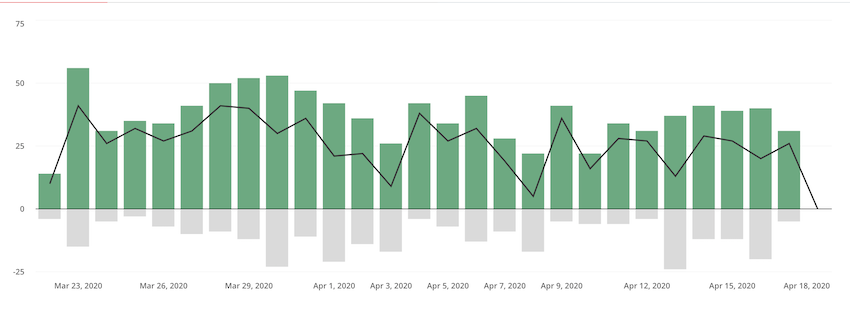
Tip 5 summary: people are looking at the text around your subscribe forms.
Test, test, test. Double down on what works, leave what didn’t work behind.
What have we learned?
Webinar marketing is still quite effective, and going live is a great way to connect with your audience, build urgency, create disappearing bonuses, and, most importantly, sell your digital products and services.
Here are the main takeaways:
- Market the heck out of your thing. Create a marketing engine that runs smoothly, and give it enough effort before you decide that “strategy x” doesn’t work for you.
- Start simple, then add complexity after you’ve mastered the first step.
- Build a higher-end product for an adjacent audience. Then start marketing it, and understand that because it’s higher end, the sales cycle might be a bit longer.
- Lean on your business friends, especially the ones that have your best interests at heart. They’re the ones you want to keep close, anyway.
- Experiment with a different pricing strategy.
- Swap out text to gain more email subscribers.
What you should do now
If you’re serious about becoming great at marketing your own thing, you should download our amazing webinar success checklist. It contains everything you need to create your own webinar, in the right order.
